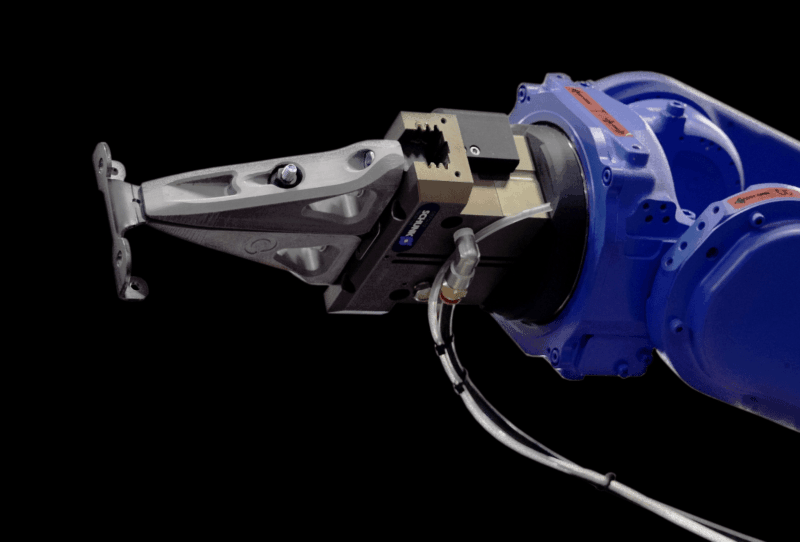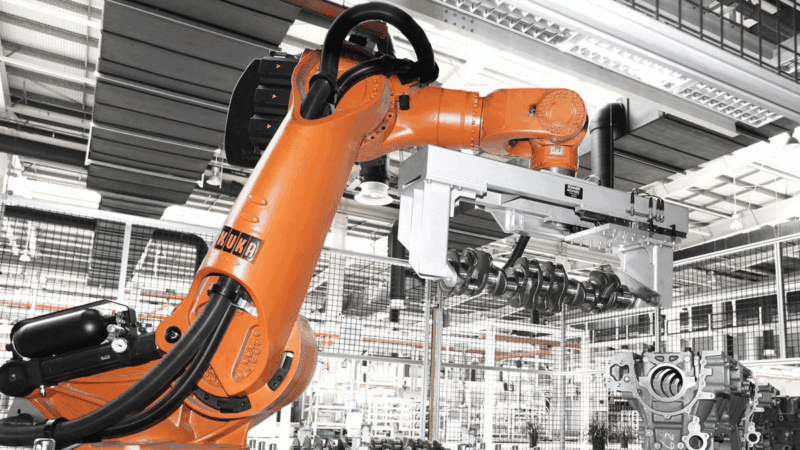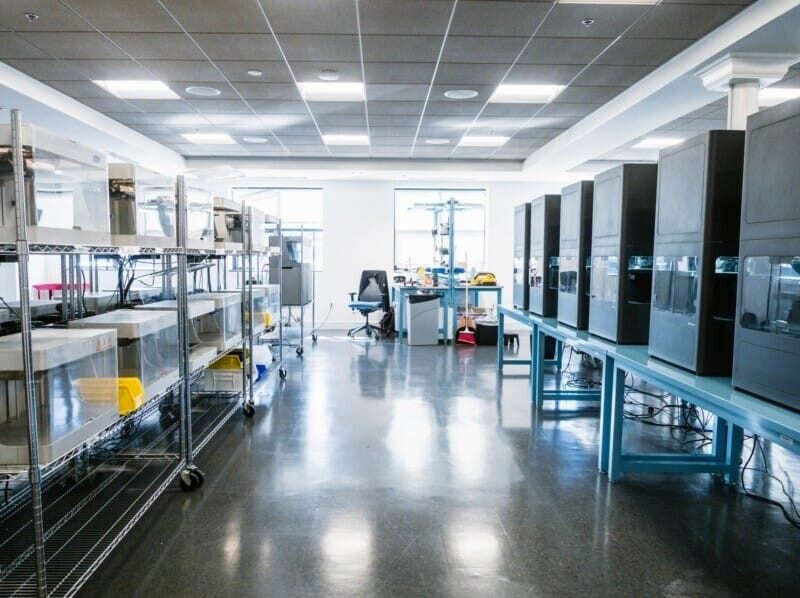
Scaling Up Additive Manufacturing In 4 Steps
In recent years, additive manufacturing technologies have progressed significantly on all fronts — not just the machines themselves, but also the 3D printing software and materials. Due to the potential flashed by additive manufacturing in its earlier stages, competing 3D printer companies have accelerated the pace of innovation up to where we are today.
Now, that initial promise has been realized: additive manufacturing is here as a consistent and reliable mode of production with distinct advantages over traditional manufacturing processes. McKinsey & Company writes that today’s professional 3D printers are overcoming the “perceived limitations of their predecessors.” While earlier industrial 3D printers were typically relegated to use as rapid prototyping machinery, today’s composite printers and metal 3D printers make sense as primary modes of production: “Faster machines, better materials, and smarter software are helping to make AM a realistic solution for many real-world production applications.”
Despite the maturation of commercial 3D printing technologies, barriers to scaled adoption into production environments still exist. But the biggest barrier to additive adoption, as cited by industry experts and analysts, isn’t the technology itself. Rather, it’s the often underestimated need for organizations to develop a holistic strategy to maximize the impact of their additive manufacturing investment.
For organizations entertaining their first forays into implementing industrial-scale 3D printing, it can be hard to know where and how to start. This article provides a framework for navigating the path of scaling up use of professional 3D printers — from the early exploratory stages, all the way up to industrial-scale production.
Why Build an Additive Manufacturing Scaling Strategy?
A successful implementation to incorporating scaled, additive manufacturing goes beyond simply purchasing the 3D printers. Having the right approach can both maximize the return on investment (ROI) from a 3D printer purchase, while also subverting unnecessary risk.
For organizations still in the purchasing process, the following considerations should be assessed:
- Where are the pain points in your manufacturing process?
- What are the non-negotiables for an additive manufacturing solution?
- How does this fit into the day to day workflow?
- How do you educate your workforce?
- What happens if something fails/goes wrong/doesn’t work?
- How does additive manufacturing connect to the existing technologies used in house?
- What do you define a successful implementation?
Step 1: Build a Dedicated Additive Manufacturing Team
Every successful business initiative starts with a strong team. Organizations should consolidate AM efforts across the entire organization, building one dedicated, core additive manufacturing team with the relevant stakeholders. This team can serve as an organization-wide resource for sharing all incoming developments and knowledge related to additive manufacturing. The initial funding for the first forays into additive manufacturing should be determined and allocated during this period, and test equipment — oftentimes 1-2 desktop 3D printers — brought in to experiment with.
At this stage, engineering and product development teams can grow familiar with the professional 3D printers, 3D printing software, and basic design and printing workflows. Unlike earlier 3D printers, modern professional 3D printers are much more user friendly, with a much less steep learning curve. The most advanced professional 3D printers can be operated effectively with no prior additive manufacturing expertise.
Step 2: Getting Started
With one or more professional 3D printers, the team can gradually shift production of parts from traditional manufacturing processes to additive manufacturing. At this stage, less-critical parts should be the focus, using the 3D printer for AM applications such as rapid prototyping (with design validation materials such as Precise PLA) and fabricating tooling (with stronger materials such as Onyx). These different materials can be printed on the same 3D printer.
Here, engineering departments should be involved in determining which parts are ideal for additive manufacturing fabrication. Despite the advantages of 3D printing, the organization may still be limited to only one or two professional 3D printers; to make the best use of resources, specific criteria should be outlined to determine which parts make the most sense to produce through 3D printing.
The core AM team spearheading the initiative should be sure to involve other stakeholders and departments to generate excitement and buy-in for a larger-scale implementation of additive manufacturing across the organization. The team should focus on educating relevant stakeholders.

Step 3: Experiment and Build
Organizations at this step are ready to more comprehensively experiment with additive manufacturing. Product development and engineering should branch out and experiment with a larger breadth of additive manufacturing applications and design modalities — this can mean different types of parts, materials, and fiber reinforcement strategies for additional strength.
This is the phase where organizations will build up in-house design and production management expertise, which will be transferred to engineers and operators. New workflows specific to additive manufacturing may be built out, with production for parts that have been rapidly prototyped and validated. Individual engineers and operators for the professional 3D printers will also develop more comprehensive additive manufacturing skill sets — design for additive manufacturing (DfAM), quality management practices, and AM-specific production management.

Step 4: Assess and Scale
Here, organizations have already validated the use of additive manufacturing for the initial, small-scale production of parts. The next focus should be scaling up the use of additive manufacturing into a wider breadth of applications, while also formalizing processes with professionalized management of the AM ecosystem. For larger organizations, having an additive manufacturing center of competence — acting as a centralized resource for AM knowledge, capabilities, and processes — can help keep the scaling process smooth and with the least risk.
As value and return on investments are assessed, promising results from the initial investigations into implementing additive manufacturing may prompt organizations to consider bringing in further additional 3D printers to support new capabilities and business models. Bringing in additional equipment for new additive manufacturing capabilities beyond the initial use cases and proposed applications might also be considered — metal 3D printers and large-format 3D printers can bolster production capabilities and extend the benefits of 3D printing into new areas of opportunity for the business.
For large manufacturers that span across multiple geographic locations, a distributed manufacturing model — with many professional 3D printers located at different manufacturing sites, each connected to the same cloud network — will streamline supply chains and enable just in time (JIT) manufacturing strategies with leaner inventories.
Learn More About Additive

Additive Manufacturing in 2022: Why Additive, and Why Now?

Industry 4.0 in the Context of Professional 3D Printers

Additive Manufacturing History: From the 1980's to Now
All of the blogs and the information contained within those blogs are copyright by Markforged, Inc. and may not be copied, modified, or adopted in any way without our written permission. Our blogs may contain our service marks or trademarks, as well as of those our affiliates. Your use of our blogs does not constitute any right or license for you to use our service marks or trademarks without our prior permission. Markforged Information provided in our blogs should not be considered professional advice. We are under no obligation to update or revise blogs based on new information, subsequent events, or otherwise.
새로운 정보를 놓치지 마세요
Markforged의 최신 컨텐츠를 편지함으로 받으시려면 구독하십시오.
